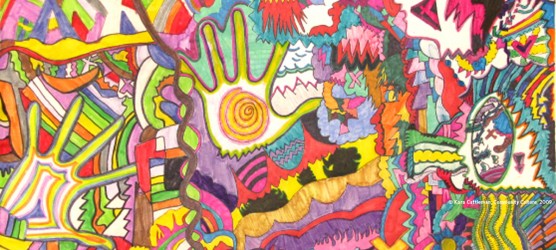Article Origin
Volume
Issue
Year
Now in its final months of exhibition, the Maskwacîs (Bear Hills) art show is sharing its special story at the Royal Alberta Museum in Edmonton.
Over the past two and a half years, more than 85,000 people have seen the exhibition and the feedback has been tremendous.
“It’s been really well received because it’s eclectic, a really in-depth snapshot from artists of all ages and skill levels, from senior to six,” said co-curator Sandi Hiemer. “How do you represent such a vivid and diverse community in one show? How do you capture all there is to say?”
The Maskwacîs exhibit was created when Hobbema was in the news all the time, but not in a good way, said Shane Golby, manager/curator of the Alberta Foundation for the Arts Travelling Exhibition Program. “I’ve been a classroom teacher in cross-cultural ways, and I know that what most of us get via the media is only a part of the story. So we approached them to give us a different look at life there.”
Curated by Hiemer and Myra LaFrance, both teachers at the culturally based Meskahna ka Nipa Wit school (also known as Montana School), the exhibit represents real life in the Bear Hills community.
“One of the important parts of the show was to provide a more complete perspective,” said Hiemer. “The whole point was to provide a counter balance to the public narrative that surrounds the community.”
“Our youth were being shadowed by activity they had nothing to do with,” said LaFrance.
To shine a more positive light on their community, the Montana School students had already produced a book of their own photography that represents many of the positive and healthy things they see every day. Titled “Can You See Me,” the book was shown at the Nina Haggerty Gallery and has since grown to the creation of three books. It brought the school and the hard work of its students and teachers into the media spotlight.
“I was brought in to help curate the art work for the Bear Hills exhibit,” said LaFrance. “My father is from the Maskwacîs area and his ancestry is Samson Cree Nation. My mother is Blackfoot from the south, so I have a wider perspective of what the culture looks like. I know the people, have taught in the community.”
The call for submissions had already gone out when LaFrance joined the team, and she was struck by the quality of the art they received for consideration.
“There were lots of beautiful things,” she said. “Photos, paintings, beadwork. For cultural reasons we could not allow some of them to go on the road, and I felt bad that I couldn’t say yes, but they understood.”
After consultation with Elders, the culturally sensitive selections were made in a slow and painstaking process. People worried about the safety and handling of their personal items, she said. For instance, a medicine pouch with decades of history features stunning beadwork. It’s included in the exhibit, but is enclosed so it can’t be touched. A beaded stick, traditionally made with a story attached to it, has colours representing all the Creator’s people, not just First Nations.
“Overall, we submitted 18 pieces from the community, and I believe they have expanded on that. We had to make sure to acknowledge all the four bands here, and all the submissions,” said LaFrance.
Through the books published by the students and through the Maskwacîs exhibit, LaFrance sees a better future emerging for the Bear Hills area.
“We’re coming out of that residential school era and willing to show how we’re developing in this era,” she said. “The significance of the art show is to bring acknowledgement that our communities do hold people with such a diverse talent. We’ve gone from being a people who live off the land to taking that knowledge and bringing it into today’s culture.”
Added LaFrance, “It’s been a great experience for the young artists in our community, and anything positive we can do for the youth is so significant.”
The Maskwacîs (Bear Hills) exhibit will be on display at the Royal Alberta Museum until September, when it relocates to Concordia University College for one month.
It will move to Ardmore for October, to the Onoway Public Library for November and to a local school in Edmonton for December. Then it will be retired and the pieces returned to their owners.
The Maskwacîs (Bear Hills) exhibit is one of three Syncrude-sponsored First Nations exhibits organized by the Art Gallery of Alberta that is traveling the province.
- 2579 views

